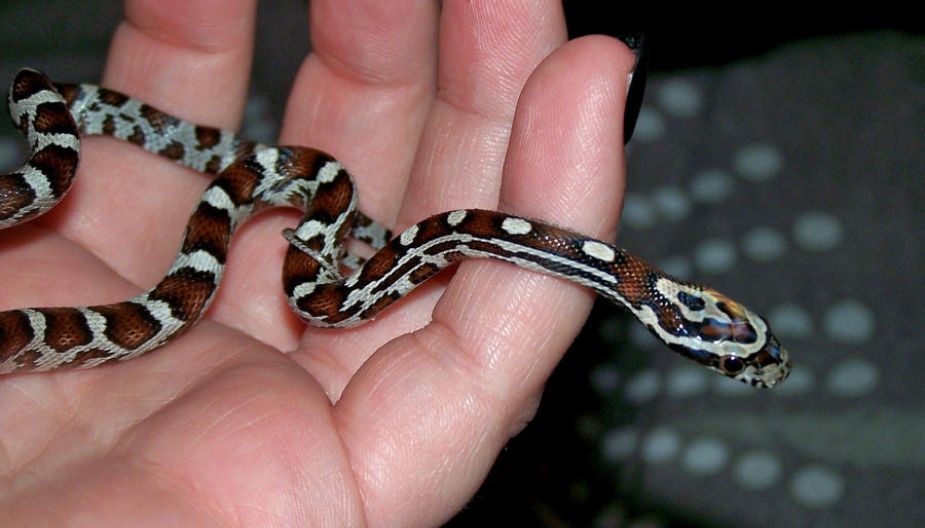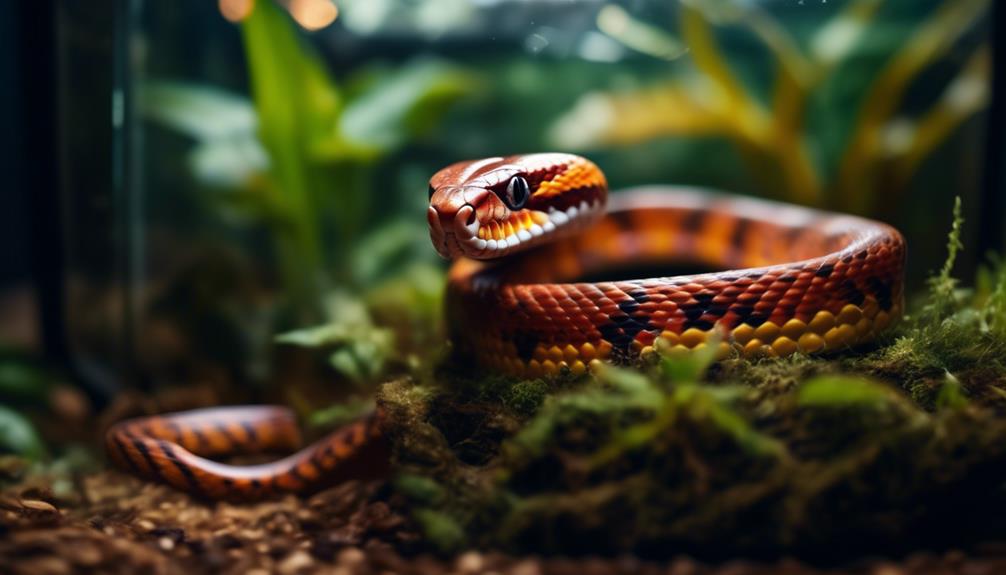While you might think that caring for an exotic snake is beyond your expertise, albino corn snakes are surprisingly manageable and make for a fascinating addition to your life.
You’ll find that these creatures are more than just their stunning albinism; they embody a gentle temperament that’s ideal for both novice and experienced snake owners.
As you navigate the captivating nuances of their care, from the specific temperature gradients to their dietary preferences, you’ll discover that there’s a profound sense of achievement in creating the perfect environment for these rare reptiles.
So, prepare to uncover the inherent beauty and the unexpected simplicity of nurturing an albino corn snake, and let’s embark on a journey that promises to transform your understanding of these extraordinary animals.
Albino corn snakes are visually striking reptiles that lack melanin, resulting in their characteristic red eyes and pale, patterned scales. To ensure their optimal health and well-being, it’s crucial to create an ideal habitat that mimics their natural environment, provide a varied diet, and establish a consistent feeding routine while building trust through safe and stress-free handling techniques.
Unveiling the Albino Mystique
You’re about to uncover the genetics behind the albino corn snake’s striking appearance.
Albinism in these reptiles results from a recessive gene mutation that inhibits melanin production, leading to their distinctive red eyes and pale scales.
The inheritance of this trait follows Mendelian principles, offering a clear pattern for breeders and geneticists to predict offspring phenotypes.
Understanding Albinism in Corn Snakes
You’re about to uncover the genetic marvel of albinism in corn snakes, a condition characterized by a lack of melanin which results in their distinctively pale coloration.
As you explore how these snakes emerged through selective breeding, you’ll see the role that heredity plays in creating their striking appearance.
You’ll also differentiate between the various morphs of albino corn snakes, each distinguished by subtle variations in hue and pattern.
The Science Behind Albinism
Albinism in corn snakes is a genetic anomaly that results in the absence of melanin, the pigment responsible for their typical coloration.
- Amelanistic gene: The albino corn snake’s mutation leads to albinism.
- Recessive trait: Albinism manifests when two carriers reproduce.
- Homozygous condition: Two copies of the mutation are necessary.
- Genetic inheritance: Offspring inherit the trait from both parents.
- Pigment synthesis: The mutation disrupts melanin production.
How Albino Corn Snakes Came to Be
Delving into the origins of albino corn snakes, it’s essential to understand that selective breeding by herpetoculturists has amplified this naturally occurring genetic mutation within captive populations.
The breeding history of the albino corn snake underpins its popularity rise, as each albino region—areas in their DNA—was methodically paired to sustain the mutation.
This meticulous propagation has secured their place in the herpetological community.
Exploring Different Types of Albino Corn Snakes
Building on the rich breeding history of albino corn snakes, it’s imperative to distinguish the various strains that exhibit this genetic anomaly, each with its distinctive patterns and hues.
- Pantherophis guttatus var. blue albino corn snake: Exhibits a muted, steely-blue sheen.
- lavender albino corn snake: Characterized by a pale, purplish body coloration.
- black albino corn snake: Displays a contrasting dark patterning.
- red albino corn snake: Features a deep, crimson saturation.
- pink albino corn snake: Noted for a soft, rosy blush across its scales.
The Genetics of Albino Corn Snakes
You’ll find that albino corn snakes owe their striking appearance to a recessive genetic mutation affecting melanin production.
As you explore their inheritance patterns, you’ll see how two carriers can produce albino offspring, a critical factor for breeders aiming for this phenotype.
Ethical breeding requires understanding these genetics to avoid health risks associated with albinism, such as vision problems and increased sensitivity to light.
Unraveling the Inheritance Patterns
To comprehend the distinct appearance of albino corn snakes, it’s essential to understand the recessive genetic trait that governs their albinism.
- Recessive Alleles: Both parents must carry the trait for a baby albino corn snake to express albinism.
- Homozygous Offspring: Albino corn snakes are homozygous for the albinism trait.
- Phenotypic Expression: Lack of melanin results in their characteristic red, orange, and white coloration.
- Snow Albino Corn Snake: A variant with a unique, paler pigmentation due to additional genetic mutations.
- Punnett Squares: Utilized to predict the inheritance patterns and likelihood of albino offspring.
Ethical Considerations in Selective Breeding
As we delve into the selective breeding of albino corn snakes, it’s crucial to consider the ethical implications of manipulating genetic traits for aesthetic purposes.
| Aspect | Ethical Consideration | Expert Insight |
|---|---|---|
| Genetic Diversity | Preventing bottleneck effects | Encourages varied gene pool |
| Health Concerns | Mitigating hereditary health issues | Monitors for genetic defects |
| Natural Habitat | Maintaining ecological balance | Studies impact of release |
| Welfare Standards | Ensuring quality of life | Establishes care guidelines |
| Consumer Awareness | Educating on responsible ownership | Advises on natural behavior needs |
Understanding Risks Associated with Albinism
While albino corn snakes exhibit a striking appearance, their lack of melanin increases their susceptibility to various health challenges and environmental risks.
- Sensitivity to UV radiation, necessitating controlled exposure
- Propensity for skin cancers due to reduced melanin protection
- Visual impairments affecting hunting and feeding efficiency
- Potential for shorter albino corn snake lifespan compared to pigmented variants
- Increased difficulties in shedding, requiring attentive habitat humidity management
Appearance and Variations
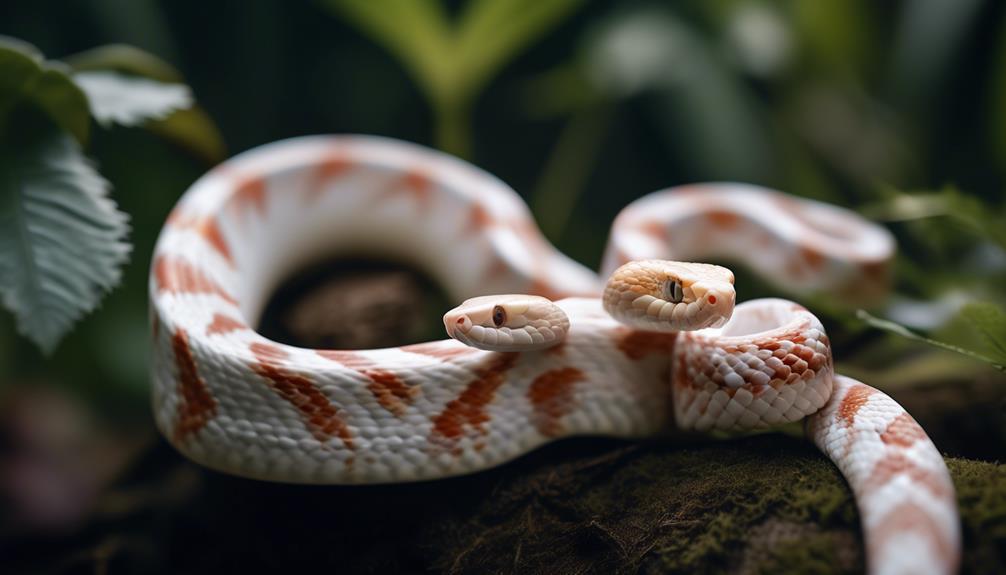
As you observe albino corn snakes from hatchling to adulthood, you’ll notice a spectrum of color variations unique to each individual. These snakes exhibit a distinct lack of melanin, resulting in their characteristic red eyes and pale, patterned scales.
The precise genetic mutation responsible for albinism in these reptiles leads to a range of appearances, even within the same clutch of eggs.
From Hatchling to Vibrant Adult
You’ll observe that as your albino corn snake matures from a hatchling to an adult, its appearance evolves significantly. The typical morph exhibits a distinctive absence of melanin, resulting in a pale scale coloration with contrasting patterns.
Exploring popular albino morph combinations reveals a variety of unique physical traits, contributing to their broad appeal among collectors and hobbyists.
Describing the Typical Albino Corn Snake
Gliding through their enclosure with a distinctive lack of pigment, albino corn snakes exhibit a striking appearance that ranges from bright yellow to deep orange with contrasting white or light patterns.
- Hatchling Stage: Vibrant hues, rapid growth rate
- Juvenile Phase: Increased size, pattern definition
- Adult Features: Full-grown albino corn snake reaches up to 5 feet
- Color Intensity: Depends on genetic variability
- Market Value: Albino corn snake price varies by lineage and rarity
Exploring Popular Albino Morph Combinations
Building on the striking appearance of the typical albino corn snake, enthusiasts often seek out the diverse range of morph combinations that add to their allure. This includes everything from the subtle shifts in hatchling patterns to the vibrant intensity of adults.
For those looking to buy albino corn snake variants, the snow morph is particularly coveted. Snow morphs have immaculate white scales that give them a stunning and unique look.
Another highly sought-after albino corn snake variant is the caramel morph. Caramel morphs feature rich, golden hues that make them stand out from the crowd.
Unique Physical Traits of Albino Corn Snakes
Albino corn snakes exhibit a striking array of physical traits that transform dramatically from the delicate patterns of their hatchling stage to the vivid colorations they develop as adults.
- Amelanistic: Lacking melanin, resulting in red eyes and a white-to-yellow base color.
- Hatchling Hue: Pinkish or pale at birth, deepening with age.
- Pattern Diversity: Varied saddles and stripes, unique to each snake.
- Visibility: High contrast against natural environments.
- Lifespan Indicator: Color deepens with longevity.
Recognizing Individuality in Albino Corn Snakes
Despite their shared genetic mutation, individual albino corn snakes exhibit a remarkable variety of patterns and color intensities. When you’re observing a baby corn snake, you’ll notice that even at a young age, subtle distinctions can be seen. These variations become more pronounced as they mature.
Enthusiasts often marvel at the individuality displayed in the pigment distribution and the contrast between the stark white and vivid yellows or oranges.
The specific genetic lineage of albino corn snakes contributes to these differences, with some lineages known for producing particularly vibrant or distinct patterns. Interaction with breeders and other hobbyists can provide insights into recognizing these unique traits.
Accurate identification is essential, not only for appreciation but also for breeding purposes where genetic diversity and individual characteristics are highly valued.
Creating the Perfect Home
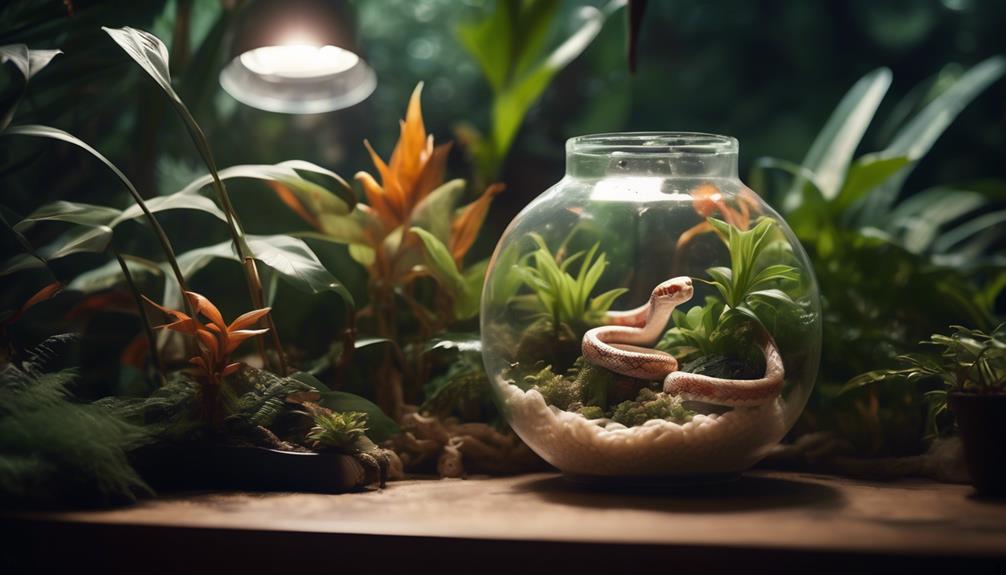
To ensure your albino corn snake thrives, you must create an enclosure that mimics its natural habitat. This involves maintaining ambient temperatures of 75-85°F with a basking spot of 88°F, and relative humidity levels between 40-50%.
Adequate hiding spots and substrate for burrowing are crucial to provide the necessary environmental enrichment for these visually striking reptiles.
Setting Up the Ideal Enclosure
To ensure your albino corn snake thrives, you’ll need to consider several factors in its enclosure setup.
Firstly, select an enclosure that provides ample space for movement and growth. Snakes, including corn snakes, need enough room to stretch out and explore their environment. A general rule of thumb is to have a tank or terrarium that is at least two-thirds the length of the snake.
Secondly, create a thermal gradient within the enclosure. This means having different temperature zones that the snake can move between to regulate its body temperature. One end of the enclosure should be warmer, with a temperature range of around 85-90°F (29-32°C), while the other end should be cooler, around 75-80°F (24-27°C). This gradient allows the snake to choose the temperature that suits its needs at any given time.
Thirdly, maintaining appropriate humidity levels is crucial for the health of your albino corn snake. Corn snakes are native to the southeastern United States, where humidity levels can be relatively high. Aim for a humidity range of 40-60% in the snake’s enclosure. This can be achieved by misting the enclosure with water and providing a water dish for the snake to drink from.
Choosing the Right Tank Dimension
When setting up the ideal enclosure for your albino corn snake, it’s essential to select a tank with dimensions that provide ample space for movement and enrichment.
- Length: Minimum of 30 inches for juveniles; adults may require up to 48 inches.
- Width: At least one-third the length of the snake.
- Height: Generally, 12-18 inches suffices.
- Volume: Consider a 20-gallon tank as a starting point.
- Cost: Factor in long-term investment for a suitable habitat.
Creating a Gradient for Optimal Comfort
Ensuring your albino corn snake thrives involves creating a thermal gradient within the enclosure, providing areas of varied temperatures for essential physiological regulation.
Position a heat source at one end to establish a high-temperature zone, crucial for metabolic processes. Gradually decrease the temperature towards the opposite side, allowing for thermoregulation.
Maintain a range between 75-85°F, with a basking spot near 90°F, to mimic their natural habitat.
Maintaining the Right Moisture Balance
Just as vital as temperature regulation, maintaining the correct humidity levels in your albino corn snake’s enclosure is essential for its health and well-being.
- Maintain humidity between 40-50% to mimic their natural habitat.
- Use a hygrometer for precise monitoring.
Mist the enclosure as needed, avoiding excess moisture.
- Provide a moisture-retentive substrate like cypress mulch.
- Include a hide box with moist sphagnum moss for shedding assistance.
Providing a Safe and Stimulating Foundation
To create an ideal habitat for your albino corn snake, start by selecting an enclosure that provides ample space for movement and exploration.
Ensure the vivarium maintains a thermal gradient, with a basking area between 85-88°F and a cooler zone around 75°F.
Incorporate hides and climbing branches to simulate a natural environment, promoting physical activity and reducing stress for optimal health and well-being.
Enriching the Albino Corn Snake’s Environment
You’ll enhance your albino corn snake’s habitat by incorporating climbing branches and hides, which simulate their natural arboreal tendencies and provide necessary seclusion.
Ensure they’ve access to fresh, clean water by including a shallow dish that’s easily accessible.
Introduce a variety of substrates, textures, and scents to stimulate their senses and encourage natural behaviors.
Incorporating Climbing Branches and Hides
Enhancing an albino corn snake’s habitat with climbing branches and hides is essential for mimicking their natural environment and promoting physical and mental well-being.
- Varied Branch Thickness: Stimulates muscle development, enhances locomotion.
- Stable Anchoring: Prevents injury from falls.
- Multiple Hides: Offers security, stress reduction.
- Thermal Gradient Consideration: Ensures behavioral thermoregulation.
- Non-Toxic Materials: Averts chemical exposure, ingestion hazards.
Offering Fresh, Accessible Water Sources
While ensuring your albino corn snake can climb and hide is crucial, equally vital is providing a constant supply of fresh water to maintain their hydration and assist in shedding.
| Water Bowl Material | Advantages |
|---|---|
| Ceramic | Non-porous, Easy to sanitize |
| Stainless Steel | Durable, Resistant to damage |
| Plastic | Lightweight, Inexpensive |
| Glass | Transparent, Simple to clean |
Adding Variety with Textures and Scents
Introducing a variety of textures and scents into your albino corn snake’s habitat can significantly enrich their sensory experience and mimic the diverse environment they’d encounter in the wild.
- Substrate Diversity: Incorporate varied substrates like aspen shavings and coconut fiber for tactile stimulation.
- Climbing Structures: Offer branches and vines for proprioceptive feedback.
- Hiding Spots: Create microhabitats with bark and hollow logs.
- Aromatic Plants: Introduce non-toxic, scent-bearing flora.
- Food Variety: Rotate prey items to provide olfactory enrichment.
Feeding Your Albino Corn Snake

You must carefully select appropriate prey size for your albino corn snake, typically choosing items that are no larger than the snake’s widest body part.
Establishing a consistent feeding routine can enhance your snake’s overall health and reduce stress.
Building trust with gentle handling can facilitate feedings and foster a positive snake-owner relationship.
Choosing the Right Prey Size and Type
As you nurture your albino corn snake, it’s critical to align the prey size with the snake’s developmental stage to promote optimal growth.
Incorporating a diverse diet not only ensures nutritional adequacy but also supports the snake’s overall health.
Observing your albino corn snake’s feeding behavior provides insights into their preferences and can help adjust feeding schedules and prey selection for their well-being.
Matching Prey Size to Growth Stages
Selecting the appropriate prey size for your albino corn snake is crucial, as it should correspond with the snake’s current growth stage to ensure optimal health and digestion.
- Neonates: Feed pinky mice, approximately 10% of hatchling mass.
- Juveniles: Progress to fuzzies, then hoppers as girth increases.
- Subadults: Offer subadult mice, matching snake diameter.
- Adults: Adult mice or small rats, bi-weekly.
- Observe: Post-feeding bulge, not distension.
Variety is Key for a Healthy Diet
To maintain your albino corn snake’s health, it’s essential to incorporate a variety of prey types into their diet beyond just size adjustments. Offer both rodents and birds to mirror their natural foraging behavior.
Select appropriate prey sizes—neonates generally consume pinkie mice, while adults can handle larger items like adult mice or weanling rats, ensuring metabolic and nutritional requirements are consistently met.
Understanding Albino Feeding Behaviors
While a varied diet is crucial for your albino corn snake’s health, understanding their specific feeding behaviors is equally important for choosing the right prey size and type.
- Offer prey that’s approximately 1.5 times the snake’s midsection girth.
- Utilize frozen-thawed rodents to minimize risk of injury.
- Maintain a feeding schedule of 5-7 days for juveniles, and 7-10 days for adults.
- Observe for refusal signs, indicating stress or illness.
- Gradually increase prey size as the snake grows.
Building Trust and Establishing Routine
To foster trust between you and your albino corn snake, it’s essential to handle them in a safe and stress-free manner. You’ll need to observe their behaviors closely, offering positive reinforcement to encourage interaction and reduce potential discomfort.
It’s crucial to recognize and interpret signs of stress, such as hissing or rapid retreats, to ensure a healthy feeding routine and bond.
Techniques for Safe and Stress-Free Handling
Establishing a routine for feeding your albino corn snake is essential in building trust and ensuring your pet’s handling remains safe and stress-free. Here are key steps:
- Feed your snake consistently every 5-7 days.
- Use feeding tongs to prevent accidental bites.
- Offer pre-killed prey to avoid injury.
- Observe your snake’s response to different prey sizes.
- Allow your snake to fully digest before handling.
Fostering Interaction and Positive Reinforcement
Fostering a bond with your albino corn snake hinges on consistent, positive interactions during feeding times. This can reinforce trust between you and your pet.
Establish a routine by offering meals at regular intervals. Use feeding tongs to simulate natural prey movement. This methodological approach minimizes stress.
It habituates your snake to your presence and facilitates a conditioned positive response to handling and interaction.
Recognizing Signs of Discomfort and Stress
While building trust through feeding routines is crucial, it’s equally important to recognize when your albino corn snake exhibits signs of discomfort or stress during these interactions.
- Avoidance Behaviors: Continual evasion or retreat from offered food.
- Hissing Sounds: Audible exhalations indicating distress.
- Erratic Movements: Sudden, unpredictable actions or recoiling.
- Refusal to Feed: Persistent disinterest in consuming prey.
- Constricted Pupils: May signal heightened alertness or agitation.
Health and Care Essentials
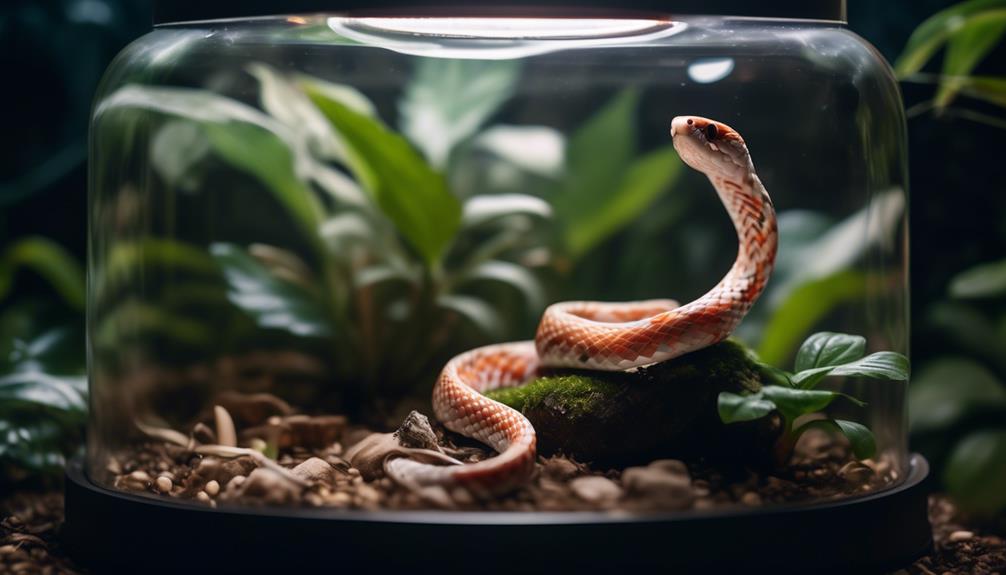
As you maintain your albino corn snake’s habitat, it’s crucial to monitor its ecdysis, ensuring that the shedding of the keratinized epidermis is complete and free of complications.
Proper hygiene practices, including regular enclosure cleanings and parasite checks, are paramount in preventing infections and promoting overall health.
Stay informed on the latest herpetological care techniques to provide your snake with an environment that meets its physiological and behavioral needs.
As an albino corn snake owner, you’ll observe the shedding process, which is critical for growth and health.
You must recognize the shedding stages, from the dulling of scales to the final sloughing, to provide appropriate care.
If your snake experiences difficulties, it’s essential to know when to assist and how to maintain optimal humidity levels to facilitate a successful shed.
Recognizing Different Shedding Stages
To ensure the well-being of your albino corn snake, it’s crucial to recognize the signs of its shedding stages. These stages include noticeable changes in color, behavior, and appetite.
- Pre-shedding Phase: Dull, lackluster scales; eyes turn opaque signifying the secretion of lubricating fluid between old and new skin.
- Blue Phase: Cloudy, bluish eye caps; significantly reduced vision.
- Clearing Phase: Eyes regain clarity as shed nears.
- Shedding Phase: Begins with rubbing against objects to peel skin.
- Post-shedding: Vibrant colors return; appetite increases.
When to Assist with Shedding Difficulties
Understanding when to intervene in your albino corn snake’s shedding process is vital, as incomplete sheds can lead to health issues such as retained shed or infections.
If you observe dysecdysis, characterized by fragmented or partial shedding, gentle assistance may be necessary. Increase enclosure humidity and provide a shedding aid, such as a moist hide, to facilitate the complete removal of the exuviae.
Ensuring Optimal Shedding Conditions
While assisting with shedding difficulties is sometimes necessary, creating the right conditions within your albino corn snake’s habitat will often prevent these issues from arising.
- Maintain a humidity level of 40-50%.
- Offer a moisture-rich hide box.
- Ensure a gradient of thermal zones.
- Provide rough surfaces for skin abrasion.
- Monitor for dysecdysis signs, intervening when necessary.
Hygiene Practices for a Healthy Snake
To ensure your albino corn snake’s health, you must regularly sanitize their habitat to prevent microbial growth and parasitic infestations.
You’ll need to safely cleanse your snake using reptile-friendly products, avoiding any that can harm their sensitive skin.
Stay vigilant for symptoms of distress or disease, such as lethargy or skin lesions, and consult a herpetological veterinarian promptly if issues arise.
Maintaining a Clean Enclosure
Ensuring your albino corn snake’s health and longevity hinges on maintaining a scrupulously clean habitat, free from contaminants and conducive to its wellbeing.
- Regular substrate replacement: Minimize microbial growth.
- Disinfection: Use reptile-safe solutions.
- Water bowl sanitation: Prevent algae and bacteria.
- Waste removal: Daily spot-cleaning is essential.
- Humidity control: Mitigate fungal development.
Safe and Effective Cleaning of Your Albino Corn Snake
Regularly cleaning your albino corn snake is crucial for preventing skin infections and promoting overall health. Utilize a gentle, reptile-safe disinfectant to meticulously cleanse the snake’s habitat.
Concurrently, inspect your snake for ectoparasites, noting any aberrations in scale texture or coloration.
Post-cleaning, ensure the environment’s humidity and temperature are restored to optimal levels for your albino corn snake’s physiological well-being.
Recognizing Signs of Illness and Seeking Help
Vigilantly observing your albino corn snake for signs of illness is essential for maintaining its health. Some common signs to watch out for include lethargy, lack of appetite, and unusual shedding. If you notice any of these symptoms, it is important to seek prompt veterinary attention.
Some specific health issues to be aware of include:
- Respiratory distress, which can be indicated by wheezing or the presence of mucus.
- Dermatological issues such as lesions or scale rot.
- Neurological anomalies, including stargazing or circling.
- Gastrointestinal complications like regurgitation.
- Behavioral changes, such as sudden aggression.
It is crucial to keep an eye out for these signs and to take action if you notice any of them in your corn snake. Remember, early intervention can make a significant difference in your snake’s health and well-being.
Enriching the Lives of Albino Corn Snakes

To enhance the well-being of your albino corn snake, incorporate engaging activities that stimulate their natural behaviors. You’ll foster a sense of responsibility and appreciation for these creatures by providing them with a habitat that challenges their problem-solving skills.
These enrichments can range from simple hide boxes to more complex structures that encourage exploration and exercise.
Engaging Activities and Games
You can enhance your albino corn snake’s environment by introducing a variety of scents to stimulate their olfactory senses.
Constructing mazes and integrating hiding spots not only encourages physical exercise but also promotes cognitive engagement.
Additionally, exposing your snake to different auditory and visual stimuli, such as music and light, may offer novel forms of environmental enrichment.
Utilizing Scents for Exploration and Enrichment
Introducing a variety of scents into the habitat of an albino corn snake can significantly enhance their sensory experiences and promote natural exploratory behaviors.
- Substrate Infusion: Embedding safe, natural odors within the substrate.
- Scent Trails: Creating trails with non-toxic, reptile-safe scents.
- Prey Scenting: Mimicking prey odors to stimulate hunting instincts.
- Habitat Variation: Rotating enclosure elements infused with different scents.
- Enrichment Objects: Introducing scent-soaked items for investigation.
Building Mazes and Hiding Places
Albino corn snakes exhibit increased physical and mental stimulation when their enclosures contain mazes and multiple hiding places, replicating the complexity of their natural habitat. Design intricate structures using safe materials to promote exploration and problem-solving behaviors.
Ensure hiding spots vary in size and texture to satisfy their instinctual need for seclusion and thermoregulation. Regularly reconfigure these elements to sustain environmental enrichment and prevent habituation.
Exploring Music and Light as Enrichment Tools
While reconfiguring the physical layout of your albino corn snake’s habitat offers tangible stimulation, incorporating auditory and visual elements such as music and light can further enrich their environment and enhance their well-being.
- Subdued lighting mimics diurnal patterns, supporting circadian rhythms.
- Soft, harmonic music may reduce stress, observing volume and frequency sensitivity.
- Intermittent light exposure stimulates natural behavior, avoiding photophobic responses.
- Utilize LED lights to simulate dawn-to-dusk transitions.
- Avoid abrupt sound or light changes to prevent startling.
Building Responsibilities and Appreciation
As you embark on the journey of caring for an albino corn snake, it’s imperative to embrace the role of a responsible reptile owner.
You’ll find that joining a community or network provides invaluable support, helping to ensure your snake’s welfare and longevity.
Inspiring Responsible Reptile Ownership
Embracing the role of a reptile guardian, you’ll discover that providing a thriving environment for albino corn snakes demands knowledge, dedication, and a deep respect for their specific needs.
- Optimize terrarium conditions, including temperature gradients (75-85°F) and humidity levels (40-50%).
- Implement a diet of appropriately sized, pre-killed rodents.
- Ensure regular, gentle handling to promote docility.
- Monitor for signs of stress or disease, such as refusal to eat or lethargy.
- Support shedding by providing a moist hide box.
Resources and Support Networks for Snake Lovers
Understanding the fundamental care requirements for albino corn snakes is just the beginning; expanding your knowledge and connecting with fellow enthusiasts can further enhance your ability to provide a stimulating environment for your pet.
Engage with herpetological societies for comprehensive care protocols.
Utilize online forums and specialized literature for behavioral studies and habitat enrichment techniques.
Join conservation groups to stay informed on ecological impacts and ethical breeding practices.
Educating Others and Fostering Appreciation for Albino Corn Snakes
To foster a deeper appreciation for albino corn snakes, it’s crucial to educate the public on their specific needs, behaviors, and the vital role they play in the ecosystem.
- Amelanistic genetics result in their striking red, orange, and yellow coloration.
- Thermoregulation is essential; they require a gradient of temperatures within their habitat.
- They exhibit crepuscular activity patterns, being most active during dawn and dusk.
- A diet primarily consisting of rodents replicates their natural predatory behavior.
- Understanding their non-venomous nature helps debunk common ophidiophobia.
Frequently Asked Questions
How Do Albino Corn Snakes Interact With Other Pets, Such as Cats or Dogs, When Kept in a Household Environment?
You’ll find albino corn snakes generally tolerate other pets if introduced carefully, but supervision’s crucial to prevent stress or injury, as their docile nature doesn’t equip them for interactions with curious or predatory animals.
Can Albino Corn Snakes Recognize Their Owners or Demonstrate Any Form of Affection Towards Humans?
You might wonder if your albino corn snake can show affection or recognize you. While not overtly affectionate, they can learn to trust and may associate you with feeding, leading to a positive response.
What Are the Ethical Considerations of Breeding Albino Corn Snakes, Given Their Genetic Mutation?
You must consider potential health issues and genetic diversity when breeding albino corn snakes. It’s crucial to avoid inbreeding and ensure their well-being over simply perpetuating their striking appearance for commercial gain.
How Does the Absence of Pigment in Albino Corn Snakes Affect Their Vision and Behavior in Comparison to Their Non-Albino Counterparts?
You’ll find albino corn snakes may have slightly impaired vision due to lack of pigment, potentially altering their behavior, like increased skittishness, compared to their pigmented counterparts.
What Is the Impact of Seasonal Changes on Albino Corn Snakes, and How Do Owners Need to Adjust Their Care Routine Accordingly?
You’ll need to adjust temperatures and light cycles for your albino corn snake as seasons change to mimic their natural environment, ensuring they remain healthy and exhibit normal behavior patterns.
Conclusion
Now you’re equipped to join the ranks of those bewitched by the albino corn snake’s ghostly allure. Like a painter mastering their palette, you’ve learned to craft a perfect habitat and provide meticulous care, all thanks to the guidance from Freptiles’ comprehensive resources.
Keep your eyes keen and your mind open; this is just the beginning of a fascinating journey. With every slither and slide, your understanding deepens, fostering a bond as unique as the pearly scales that grace your extraordinary companion.
Welcome to their world—truly, a living tapestry. As you continue this enchanting adventure, remember that Freptiles is here to enhance your experience with expert advice and insights into the captivating lives of these remarkable reptiles.

